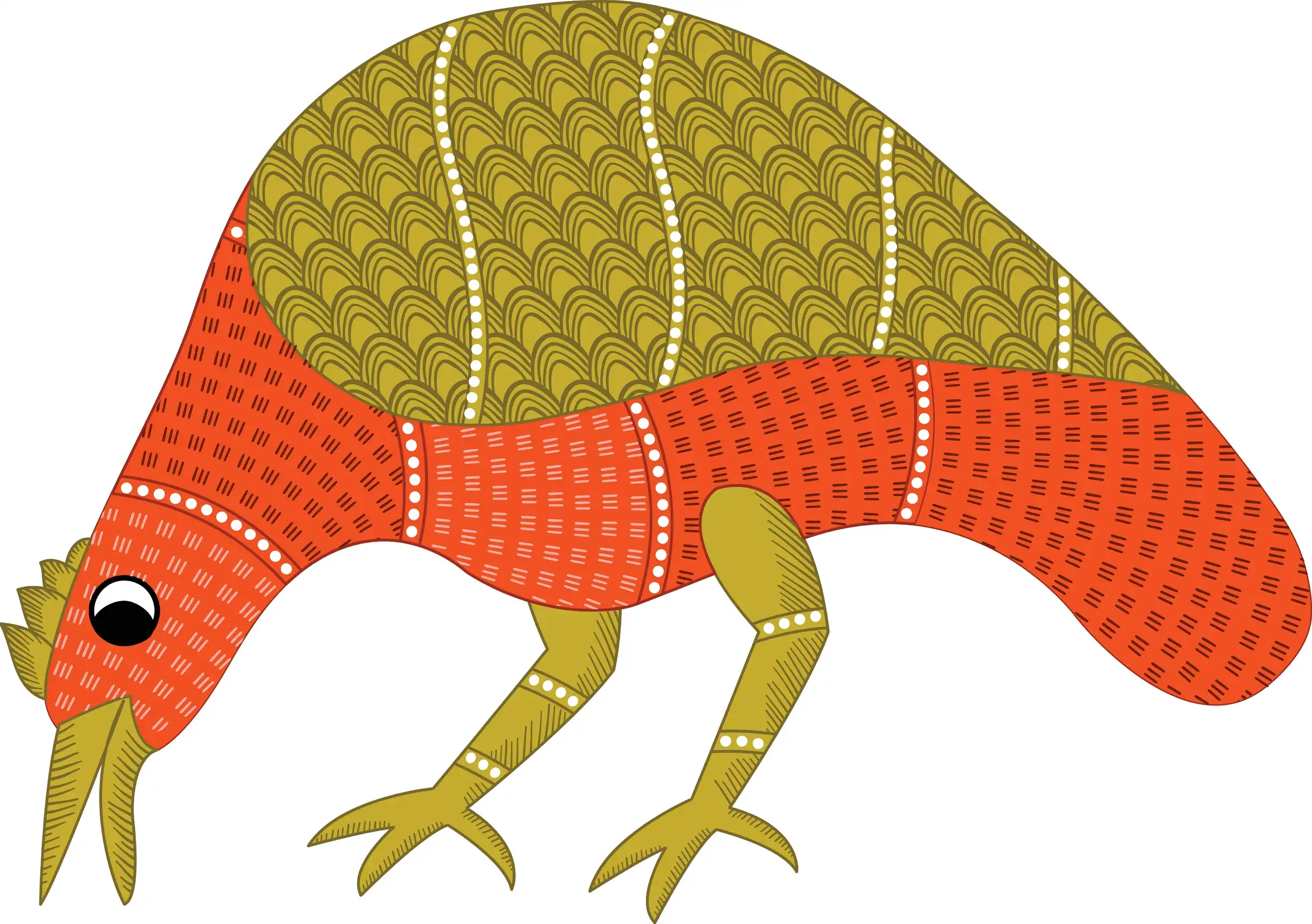Introduction
The Gonds are one of the major tribal communities in India. They originally hail from the parts of central India that include the states of Madhya Pradesh, Chhattisgarh, Maharashtra, Telangana, Andhra Pradesh, and Odisha. They have a rich and diverse cultural heritage that includes their own language, art, music, and traditional practices.
Peculiarities of Gond Society, art and culture
A gond society typically follows a clan-based social organization, where each clan holds a distinct identity and plays a crucial role in maintaining social cohesion and kinship ties. They practice a matrilineal kinship system, tracing descent and inheritance through the female line. Every gond possess a strong sense of identity and unity. Their shared cultural practices, traditions, and social organization contribute to a collective identity, fostering a sense of belonging and cooperation within the Gond society.

Bird painting
Artistic expressions hold a significant place in Gond culture. Gond art, characterized by its vivid colors and intricate designs, is renowned worldwide. Through their art, the Gonds depict the harmony between humans and nature, mythological narratives, and the sacredness of their surroundings. Music is also an integral part of their cultural fabric, with traditional songs and instruments captivating listeners.
Occupation and Livelihood of the Gonds
The Gonds’ deep connection to nature is evident in their lifestyle and spiritual beliefs. Forests, hills, and rivers hold immense significance in their lives.
- Agriculture is a primary occupation for the Gonds, involving the cultivation of crops such as millets, pulses, rice, wheat, vegetables, and oilseeds.
- Historically, hunting and gathering played a significant role in their sustenance.
- Forest-based activities that serve them in earning livelihood include collecting non-timber forest products like bamboo, tendu leaves, honey, and lac,.
- Animal husbandry is practiced by rearing cattle, goats, and poultry, providing them with dairy products, meat, and additional income through the sale of livestock-related products.
- Many Gonds also engage in wage labor, working as agricultural laborers, construction workers, domestic helpers, and in various other sectors to earn a living.
Challenges faced by the Gonds
The Gonds face numerous challenges that impact their social, economic, and cultural well-being. These challenges include land rights issues and displacement, leading to the disruption of their traditional way of life and livelihoods.
Economic disparities and limited access to education and healthcare contribute to their socio-economic marginalization and perpetuate cycles of poverty. Rapid modernization and external influences pose a risk to Gond culture, with the younger generation becoming disconnected from their heritage. Environmental degradation threatens their close relationship with the natural environment and traditional livelihoods.
Moreover, social discrimination and limited representation hinder their social mobility and participation in decision-making processes. Efforts are underway to address these challenges, including land rights movements, educational initiatives, healthcare interventions, and cultural preservation efforts. By focusing on sustainable development and empowering the Gond community, it is hoped that their well-being and rights can be safeguarded for future generations.
Summary
The Gonds, with their rich cultural heritage and intricate artistic expressions, provide a glimpse into the vibrant tapestry of indigenous communities in India. Their deep connection to nature, distinctive customs, and artistic prowess make them a remarkable group deserving of recognition and appreciation. By understanding and supporting the Gond community, we can help preserve their culture and contribute to their empowerment for generations to come.
Frequently Asked Questions
Q1. What is the religion of the Gonds?
The Gonds traditionally follow animistic beliefs, which involve worshipping spirits and deities associated with nature, ancestors, and household objects.
Q2. What is the traditional clothing of the Gonds?
Gond men traditionally wear a dhoti (loincloth) or lungi (wrap-around skirt) along with a shirt, while women wear sarees or lehengas with a blouse and adorn themselves with traditional jewelry. The clothing often features vibrant colors and intricate patterns reflecting their artistic traditions.
Q3. What is the language spoken by the Gonds?
The Gonds have their own language, known as Gondi. It belongs to the Dravidian language family and has several dialects spoken by different Gond communities.
 Mission Statement
Mission Statement
“Empower every student to achieve full potential”
88Guru has been established with the social objective of making quality video-based learning material available to all Indian students. Technology, Connectivity and Social Media are rapidly changing the world of Education and we wish to lead the transformation of the tuition industry in India.
88Guru is the perfect complement to the current tuition model. 88Guru creates a wonderful opportunity for children and parents to bond while engaging in a valuable learning activity. It also provides the complete curriculum at your fingertips for those moments when you need some help at short notice. We believe that this mode of tuition could be transformational, adding hours to a child's day while providing complete control over the learning process.
Every course is taught by the best teachers from India's top schools and conducted in an engaging manner to keep students involved. The e-learning process consists of video-based instructions, computer-graded assignments, and a dashboard which allows the student and parent to track progress.


